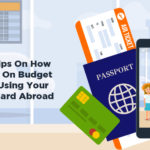 By Maria Weyman, creditcardGenius
By Maria Weyman, creditcardGenius
Special to the Financial Independence Hub
When organizing a trip, it makes sense to plan ahead for some extra spending to make the most of the experience.
Even the most frugal penny pinchers will want some extra cash to throw around while on vacation for maximum relaxation and culture absorption.
But, if you’re using your trusty credit card to earn some rewards on those purchases along the way, there may be something you’ve overlooked – foreign transaction fees – the peskiest of all credit-card fees coming in hot to totally ruin your budget.
How foreign exchange fees work
Foreign transaction fees will show up on your credit-card statement when you make a purchase with your Canadian credit card in a currency that isn’t Canadian dollars, either when travelling abroad or shopping online. You’re charged this fee in order to convert your funds to the required currency.
There are often 2 parts to this fee:
- what gets charged by the credit card issuer (Visa, Mastercard, American Express), and
- what gets charged by the issuing bank (BMO, TD, etc.)
So, not only are you losing out on the currency exchange (depending on the currency), but you’re also charged an additional fee on top of that.
The average cost of foreign exchange fees
In Canada, most foreign exchange fees are 2.5% of your total purchase, but can range from 2% all the way up to 3.5% : yikes.
Let’s crunch some numbers with some examples.
Say you’re road tripping to the U.S. and use your Canadian credit card to buy a $5 USD latte from Starbucks.
At the time of writing, 1 USD is equal to 1.34 CAD.
( $5 * 1.34 ) * 2.5%
$6.70 * 2.5% = $0.17
Ok, not unreasonable. But, the more you spend, the more it adds up…
Say you travel to Ireland and use your credit card to pay for hotel stays, dining, shopping, and sight-seeing for a week, totalling $5,000 in purchases.
At the time of writing, 1 Euro is equal to 1.51 CAD.
( $5,000 * 1.51 ) * 2.5%
$7,550 * 2.5% = $188.75
$188.75 is not as easily overlooked as $0.17 more for a coffee …
And though it may not seem like much, $200 is still a significant amount of money to figuratively throw in the trash bin if you’re travelling on a budget.
How to save money and avoid FX fees
With that being said, is there any way to escape the dreaded 2.5%?
Here are our top tips on saving money next time you’re adventuring overseas or shopping in a foreign currency:
Tip #1: Online shopping in CAD
When shopping online, it’s easy to mindlessly fill out your cart and checkout with the click of a button.
But it’s important to double check in what currency you’re purchasing your items to avoid unexpected surprises in the long run.
Tip #2: Shop local
With the convenience of online shopping, it may seem backwards to suggest shopping at brick-and-mortar shops. But there’s a valid argument to make for small local businesses in your town.
The prices may be higher, but at least you know where the extra money is going – supporting local – instead of handing over more money to the banks.
Tip #3: Exchange currency locally at a trusted money changer
Do some research before you depart on your trip into money changers in your destination country through online travel forums.
You’ll be sure to find lots of good information on where to find the best rates and what stores can be trusted. Their exchange rates are bound to be quite a bit less than your local bank here in Canada which often approaches 4%.
Just be sure to pull out your calculator to double check the numbers and never takes your eyes off your money and to count it twice before you leave to make sure you weren’t short changed.
Tip #4: Get a debit card with no ATM fees
If you don’t want to carry around wads of cash, a debit card is the next best thing.
Although all debit cards charge foreign exchange fees, there are some with free worldwide ATM withdrawals. If you use a local ATM while you’re travelling instead of converting cash ahead of time, you’ll often get a significantly lower currency exchange rate.
Make sure you carry a little bit of cash in case you have trouble finding an ATM and for emergency.
Tip #5: Get a no foreign exchange fee credit card
One final tip that will give you the biggest savings: get a credit card that waives the foreign exchange fee completely.
No matter how you choose to exchange your money, there’s always a foreign exchange fee typically between 1% and 4%.
A no foreign transaction fee credit card is the closest you can get to no fee at all. The 2.5% portion of the fee will be completely waived, leaving you to pay the exchange rate that the credit card network (Visa, Mastercard, or American Express) itself actually pays: which is usually around 0.5%.
They’re a rare breed, but there are some truly good ones out there.
Whether you prefer cash back rewards, travel rewards, or something in between, there’s a no foreign transaction fee credit card out there made for you to help you save money.
The bottom line
Nobody wants to pay for unnecessary fees. We all have better things to spend our hard-earned money on, especially while on vacation.
And though 2.5% may not seem so bad, it adds up quickly. Up to 4% at your local bank adds up even faster.
That’s why it’s so important to stay on top of you money – it’s yours, after all.
 Maria Weyman is Co-Founder of creditcardGenius, a math-based credit card comparison engine, comparing over 50 features of over 180 Canadian credit cards, so you can maximize your rewards. Rate Your Wallet is their 3-minute quiz that tells you if your card is worth the keep.
Maria Weyman is Co-Founder of creditcardGenius, a math-based credit card comparison engine, comparing over 50 features of over 180 Canadian credit cards, so you can maximize your rewards. Rate Your Wallet is their 3-minute quiz that tells you if your card is worth the keep.


